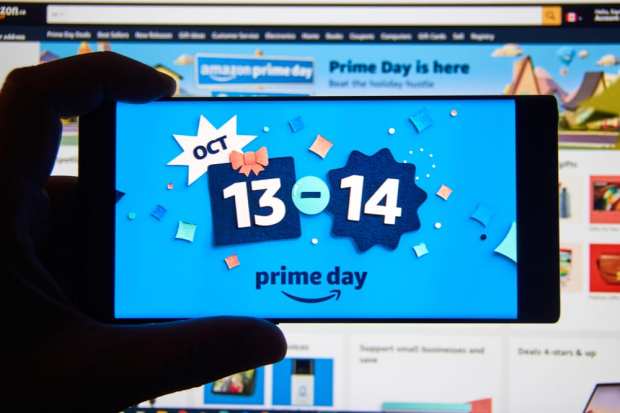Amazon Prime Day Part 1: The ‘Amazon Effect’ Goes Into Overdrive For Holiday 2020

The big “day” is finally here — well, big two days to be technically accurate, as Amazon Prime Day, the eCommerce giant’s annual shopping holiday, is now a 48-hour event that began Tuesday (Oct. 13). And the two-day event is this year performing a very different service than it does normally. Usually hosted in early July, Prime Day was conceived to give consumers a reason to go shopping during the dog days of summer when retail sales generally hit their lowest point of the year.
But 2020 threw a curveball in the form of COVID-19, and a difficult springtime scramble as consumers’ reset to digital-only lives nearly overnight threw the supply chain into a slight state of disarray. In response to the radically shifted reality that emerged in early spring 2020, Prime Day was delayed. After that the new Prime data bounced back and forth a bit — early on the forecast was for a late August or early September Prime Day and a final date was only set as of the end of September for Oct. 13 and 14.
Beyond the change in date, Prime Day 2020 has also undergone a subtle change in purpose. This year Prime Day is not about jumpstarting sales during an otherwise sluggish season — it’s about kickstarting sales for the busiest spending season of the year roughly 45 days ahead of when holiday shopping would typically begin during Thanksgiving weekend.
To say Amazon has great expectations for this year’s Prime Day is an understatement, but given the circumstances of the holiday shopping season this year, and the ways the market is restructuring, it seems the pandemic is actually a tailwind pushing the Amazon effect on retail forward even faster.
The Prime Day Push
Prime Day is always big business, good for generating a lot of consumer activity. Last year, Amazon reported its best overall sales day ever with $6.93 billion in sales generated globally and $4.32 billion in the U.S. But this year, analysts and experts are expecting much bigger things — with $9.91 billion predicted for Prime Day 2020 global sales, $6.17 billion is expected to be generated by U.S. consumers.
If Amazon is able to deliver on that $10 billion day forecast, PYMNTS quick calculations indicate that would mean Prime Day 2020 would be in line to generate roughly 2 percent of Amazon’s total annual sales doing roughly eight times its normal daily sales volume.
And, as news reports indicate Amazon and its merchants are very actively pushing deals in an attempt to capture what is widely forecast to be elevated interest, with discounts ranging through the usual Prime Day suspects like electronics and far more deeply into areas like apparel, outdoor and camping gear, designer handbags and home goods. And while home goods are usually a Prime Day favored category — the Instant Pot pressure cooker is, as always, one of Prime Day’s more heavily featured discount items — this year the goods are literally bigger as mattresses and home furnishings offerings are also proliferating on site.
There is no data as of yet out of Prime Day — Amazon offered no midway update this year and estimates by experts as of yet haven’t gone out. But even before the numbers are in, the powerful pull of the Amazon effect is already being felt as the eCommerce giant has ended up being the brand behind the event that is sparking the holiday shopping season in 2020.
A Very Amazon Holiday Season
Longtime PYMNTS readers know the story of the Amazon effect across a lot of verticals — retail, grocery, payments. Amazon enters, raises the bar and forces the rest of the ecosystem to follow on or get left behind. And as of Prime Day we are already seeing that with Amazon’s big box competitors — Walmart kicked off its Big Save promotional event Sunday night to get the drop on Prime Day with its discounts, while Target’s Deal Days are running concurrently to Prime. Best Buy didn’t bother to come up with a clever new name for its Prime counterprogramming, but it is running a host of sales on popular gift items.
Black Friday, the “traditional” shopping holiday that serves as the holiday shopping season kickoff point, however, looks to have been duly disrupted this year. First by the COVID-19 pandemic that inclines consumers to avoid crowded doorbuster events, and then by Prime Day showing up early with deals curated to appeal to the holiday season shopper.
And while the Amazon effect is in full effect already, one might watch for that to expand and deepen as the season goes on. The CDC has been pretty clear it doesn’t want consumers out shopping in crowds, and PYMNTS latest consumer survey data strongly indicates consumers aren’t really looking to get back out there any time soon. What they want, more than anything, is online inventory listing that is accurate and the option to have their goods delivered directly to their door. The degree to which they miss going to the store, the data indicates, has been somewhat overrated.
Which means as much Prime Day is already shaping to be a big win for Amazon, it might just be the opening act for its biggest win of a holiday season ever.
